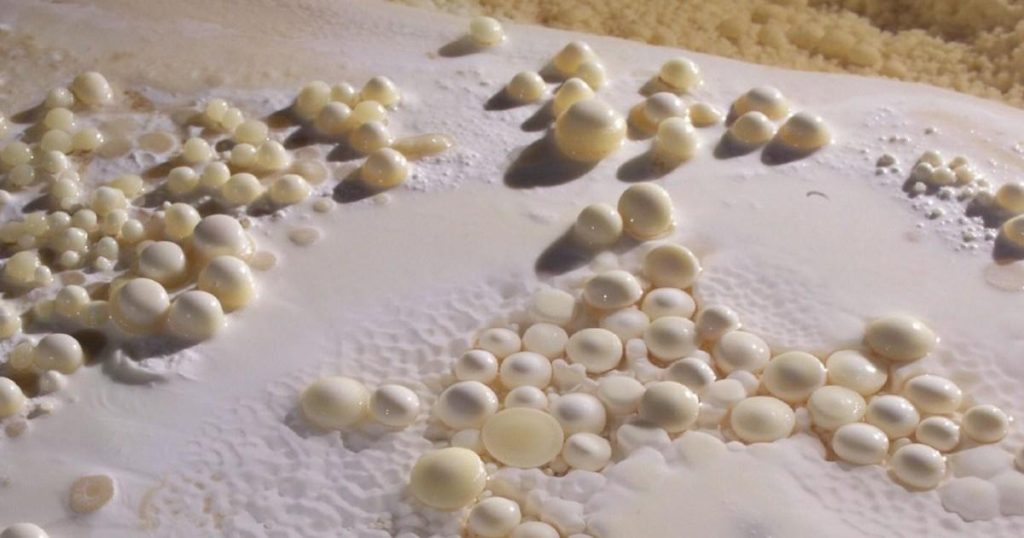The Discovery of Unique Cave Pearls Encasing Archaeological Artifacts in an Ancient Jerusalem Tunnel
In the realm of speleological wonders, a remarkable discovery has emerged from the depths of an ancient tunnel in the Jerusalem Hills of Israel. Researchers have unearthed a collection of "cave pearls," spherical mineral formations typically found in shallow cave pools. What sets these pearls apart is their inclusion of archaeological artifacts as nuclei – a phenomenon never before documented in scientific literature. This unprecedented finding offers a captivating glimpse into the history of the tunnel and the human activities that unfolded within its confines over centuries.
Cave pearls, a type of speleothem, are formed through the gradual accretion of calcite layers around a central nucleus. Unlike more familiar speleothems like stalactites and stalagmites, cave pearls are generally detached from the cave’s surfaces, residing freely in pools of water. Their spherical shape and smooth texture arise from the gentle agitation of the water, which evenly distributes the mineral deposits. While typically formed around rock fragments or mud particles, the cave pearls found in the Jerusalem tunnel exhibited a remarkable peculiarity: several contained fragments of pottery and plaster, effectively transforming them into miniature time capsules.
The discovery of these unique cave pearls occurred during a 2017 survey of the Jwoeizeh spring tunnel, an ancient man-made structure designed to extract water from underground aquifers. The Southern Levant region, where the tunnel is located, boasts some of the oldest and longest spring tunnels, dating back to the Iron Age. While exploring the tunnel, the research team stumbled upon a sealed-off segment, hidden for centuries. Within this 23-foot-long section, amidst soil and debris, lay the remarkable collection of cave pearls.
Subsequent analysis revealed the astonishing contents of these geological gems. Fourteen of the fifty cave pearls discovered contained pottery fragments as nuclei, with two of these fragments originating from ceramic lamps. An additional two pearls harbored plaster nuclei. The inclusion of these artifacts marks a significant milestone in archaeological research, offering a novel method for dating and understanding past human activities within cave environments.
Dating of the artifacts within the pearls provided further clues to the tunnel’s history. Most of the pottery nuclei dated back to the Hellenistic period (333-63 BC) and the subsequent Roman to Byzantine periods (63 BC – 7th century AD). The plaster nuclei were also attributed to the Hellenistic period. One pottery sample even hinted at a much earlier origin, potentially dating back to the Persian (535-333 BC), Babylonian (586-535 BC), or even the Iron Age. These findings suggest that the tunnel underwent reconstruction during the Hellenistic era, with the presence of ceramic lamp fragments indicating their use for illumination within the tunnel’s depths.
The presence of these artifacts within the cave pearls provides strong evidence for the tunnel’s origins and subsequent periods of use. Azriel Yechezkel, the lead author of the study, affirmed that the research supports the theory of the tunnel’s initial construction during the Iron Age. Furthermore, the dating of the artifacts within the pearls confirms a later phase of reconstruction during the Hellenistic period. This discovery sheds new light on the tunnel’s long and complex history, revealing its continuous use and adaptation across different eras.
This unique find highlights the unexpected ways in which archaeological evidence can be preserved. The cave pearls, formed over long periods by natural processes, inadvertently captured and protected fragments of human activity, preserving them for centuries within their mineral shells. The analysis of these encapsulated artifacts offers valuable insights into the past, illuminating aspects of daily life, technological advancements, and construction practices of bygone civilizations.
The discovery of archaeological artifacts within cave pearls opens up new avenues for research in speleoarchaeology. This emerging field combines the expertise of speleologists and archaeologists to explore and understand the human use of caves throughout history. The cave pearls from the Jerusalem tunnel serve as a testament to the potential of this interdisciplinary approach, revealing hidden stories within the Earth’s subterranean realm.
The careful excavation and analysis of these unique cave pearls have provided a wealth of information about the Jwoeizeh spring tunnel. The artifacts contained within them not only help to date the tunnel’s construction and later modifications but also offer a glimpse into the activities that took place within its confines. The use of oil lamps during the Hellenistic period, evidenced by the lamp fragments, paints a vivid picture of workers navigating the tunnel’s dark passages, carrying out maintenance or retrieving water.
The preservation of these artifacts within cave pearls is a remarkable example of how natural processes can contribute to the archaeological record. The pearls, formed by the slow deposition of calcite, effectively sealed and protected the artifacts from the ravages of time and the elements. This unique form of preservation provides a window into the past, allowing researchers to piece together the history of the tunnel and the people who used it.
The discovery of these remarkable cave pearls emphasizes the importance of continued exploration and research in both speleology and archaeology. The unexpected finds within the Jerusalem tunnel demonstrate that even seemingly ordinary geological formations can hold valuable clues to the past. By combining the expertise of both disciplines, researchers can unlock the hidden stories contained within these subterranean environments.
The ancient tunnel in the Jerusalem Hills has yielded a treasure trove of information thanks to the discovery of these extraordinary cave pearls. Their unique contents illuminate the tunnel’s long history, from its initial construction in the Iron Age to its later use and reconstruction during the Hellenistic period. This remarkable discovery underscores the ongoing potential for new and exciting archaeological finds, reminding us that the past can often be found in the most unexpected places. The cave pearls, once simple geological curiosities, have become valuable time capsules, offering a glimpse into the lives of those who walked the tunnel’s dimly lit passages centuries ago.




